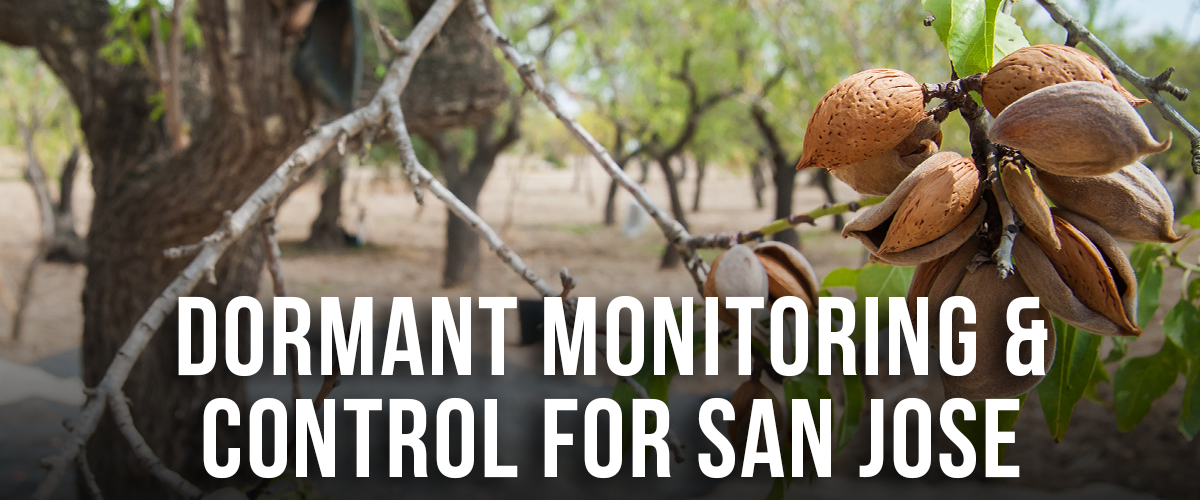One of the biggest pest control success stories in the almond industry has to be reliance on biocontrol to knock back San Jose scale (SJS).
While dormant monitoring for SJS in almond orchards is a recommended practice under UC Integrated Pest Management guidelines, use of organophosphate dormant spray applications to control this pest is now a rare occurrence in California.
In almond trees, lower branch dieback can be caused by severe infestations of SJS. This insect pest sucks juices from the inner bark of the tree by inserting mouthparts into twigs and injecting a toxin. Uncontrolled populations coalesce on branches and can kill branches within one to three years. SJS can be found on most almond varieties. Gureet Brar, former UCCE farm advisor in Fresno and Madera counties, said natural enemies can keep scale populations below economic damage thresholds, but disruption of those biocontrols due to pesticide use can result in a surge in scale population.
SJS is small, 1/16 inch in diameter and may have a white, black or brown cap covering. Feeding sites on the tree branches appear as a red halo on one-year-old green wood. Mobile scale crawlers emerge from beneath the adult female scale cover. After locating a feeding site, the tiny crawlers settle, begin feeding and later lose their antennae, legs and eyes, becoming immobile. The scale soon begin to secrete a waxy substance that covers their body. Initially, the waxy covering is white, but turns darker later in the first instar. Male SJS emerge as a winged adult and the female remains wingless under the scale covering. There can be three to four generations per season, taking about seven to eight weeks per generation.
Protect Parasitoids
With the reemergence of parasitoids as biocontrol, scale populations rarely reach high numbers in orchards, said UCCE Kern County IPM advisor David Haviland. Dormant sprays of organophosphates were once a common practice in almond orchards, but restrictions on use and concerns about surface water contamination reduced use. Growers found that without the broad-spectrum pesticides, parasitoid levels grew and became effective in keeping scale and peach twig borer below economic threshold levels in the orchard.
In years past, almond growers did spray broad spectrum insecticides to control SJS, said Jhalendra Rijal, UCCE IPM advisor in San Joaquin, Stanislaus and Merced counties. Currently, SJS levels may build up in an orchard every few years, he said, but the pest is easily controlled with a dormant oil spray that works by suppressing respiration of scale. If scale numbers build in an orchard, Rijal said that native parasitoids levels would also build and may keep scale under control.
The UC IPM guidelines note that natural enemies that feed on SJS include two predaceous beetles: the twicestabbed lady beetle, Chilocorus orbus, and another small beetle Cybocephalus californicus. Small chalcid and aphelinid wasps also parasitize this scale, including some species of Aphytis and Encarsia (=Prospaltella). These natural enemies are helpful in reducing scale numbers, but broad-spectrum insecticides used during the growing season for other pests disrupt this natural control, and scale numbers can increase as a result. Low winter mortality due to mild temperatures will also permit a buildup of scale numbers.
Sampling Protocols
Treatment decisions for SJS should be based on the level of infestation observed.
Rijal said spur sampling during dormancy along with observation in the orchard and past infestation levels will help a grower know if they need to treat for SJS. The basic sampling protocol calls for collecting 100 spurs from 35 to 50 trees across the orchard. Spurs should be collected by clipping at the base of the spur and including some old spur wood. Spurs should also be collected from both the exterior and interior tree canopy. Presence or absence of SJS for each spur is recorded. When looking at spur samples, evidence of parasitization should be noted. Parasitized scale will have emergent holes in the body of the dead mature scales. Haviland said that another indication of parasitization is the presence of frass when a scale cover is lifted.
A high degree of parasitization may indicate that scale is being controlled and no treatment is needed. Decision to treat depends on level of infestation with few or no signs of parasitization. No treatment is needed if less than 20% of the spurs (evaluated in batch of 20 spurs at a time) are infested. This link can assist with the sampling process: http://ipm.ucanr.edu/PMG/C003/almond-dormantspursampling.pdf.
The UC IPM guidelines indicate that infestation levels in more than 60% of the spur samples may require use of an insect growth regulator with the oil spray for better control. “A monitoring-based decision is the core concept of the IPM, which not only improves orchard sustainability, but also helps to save money for growers.”
Dormant or delayed dormant timed applications will be more effective as there are no leaves to shield the scale from the spray. During the summer, monitoring for the crawler stage of SJS can be done with double sided sticky tape on tree branches.
Haviland said the negative impacts on parasitoid species were found in a Pest Management Alliance project from 2000 to 2004. With that information, growers backed off on organophosphate use to control scale and went with oils, or in the case of higher infestation levels, insect growth regulators which were softer on the beneficial insects. The parasitoids responded with growth in numbers and leveled off SJS infestations in most almond growing regions.
“With the Almond Board’s push toward sustainability, biocontrol of scale is a positive move in that direction,” Haviland said. “Growers were able to reduce pesticide use, maintain tree health and have lower inputs.”












